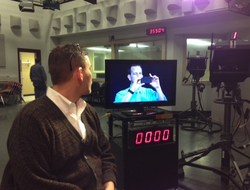 Interview in a real TV studio
Interview in a real TV studio 
Construct New Meaning From History
Seven score and ten years ago, a cabin-born forefather set forth a new inspiration for our nation called The Gettysburg Address. We’ve learned it since we were kids, you and I. Many among us know it by heart even now. For it gives us a renewed sense of purpose today. Just as it did on the chilly morning of November 19th, 1863, when Abraham Lincoln used the words to change the tide and meaning of the Civil War.
272 words. Not many of them were flashy words on their own. But together, The Address is perhaps the most profound and meaningful text in our nation’s history. Every score and each year since, scholars have debated the independent and interconnected meanings of the words and phrases Abraham Lincoln spoke that day.
Now, there’s a new way to look at The Address: in 3-D.
You see, if you write out Lincoln’s Gettysburg Address like you would a poem, there’s a quirky anomaly about it that you can explore for yourself. The words and phrases “pair up” quite curiously with other passages Lincoln also wrote.
| Take a look at the example supplied here. It’s a new idea called a “Text Pairing”. That is, we’ve “paired” The Gettysburg Address with a poem Lincoln wrote some 17 years earlier. Read it across, and you’ll discover some fascinating new imaginings about the ideas (and ideals) Lincoln sought to express throughout his lifetime. How can this impact your understanding of The Gettysburg Address? Well, as an example, scholars have long argued whether Lincoln stressed “of” or “the people”. If we consider his words paired with the companion poem, which word stress seems more likely? What other new insights can you draw from the paired texts? Neat, hunh? Now, if you’d like to explore this kind of constructionist exercise further, click here for a guided tour of Lincoln’s famous works in 3- D. When you do, the challenge to you will become clear: What meanings might you discover in the works of other heroes past by building a Text Pairing of your own? |

 RSS Feed
RSS Feed


